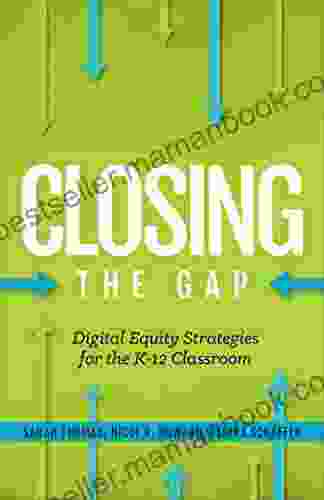Empowering Education: Digital Equity Strategies for the 21st Century Classroom

: The Imperative for Digital Equity
In the rapidly evolving digital landscape, ensuring digital equity has become paramount to creating a just and equitable society. Education, as a cornerstone of social and economic advancement, holds a pivotal role in fostering digital literacy and empowering students to succeed in the 21st century. Digital equity, therefore, becomes essential for unlocking the potential of every student and providing them with the foundation for future success.
Understanding Digital Equity: What It Encompasses
Digital equity encompasses three key dimensions:
4.2 out of 5
| Language | : | English |
| File size | : | 2074 KB |
| Text-to-Speech | : | Enabled |
| Screen Reader | : | Supported |
| Enhanced typesetting | : | Enabled |
| Print length | : | 118 pages |
| Paperback | : | 312 pages |
| Item Weight | : | 14.7 ounces |
| Dimensions | : | 6 x 0.71 x 9 inches |
- Access: Ensuring every student has access to reliable internet connectivity, digital devices, and adequate technical support.
- Skills: Developing students' digital literacy, computational thinking, and problem-solving abilities through effective instruction and hands-on experiences.
- Content: Providing students with high-quality digital educational resources, including culturally relevant and engaging content that reflects their diverse backgrounds.
Strategies for Advancing Digital Equity in the Classroom
Achieving digital equity requires a multi-pronged approach involving various stakeholders. Here are some key strategies that educators, administrators, and policymakers can implement:
1. Assess Needs and Resources
Conduct thorough assessments to understand the current digital landscape in the classroom, school, and community. Identify areas of need and available resources to develop targeted interventions.
2. Implement Equitable Access Initiatives
Provide students with access to laptops, tablets, and internet connectivity at school and home. Establish partnerships with community organizations and libraries to offer additional access points.
3. Integrate Digital Literacy into Curriculum
Incorporate digital literacy instruction into the curriculum from elementary to high school. Teach students how to critically evaluate information, collaborate online, and use technology effectively.
4. Foster Teacher Professional Development
Provide educators with professional development opportunities to enhance their digital skills and learn about best practices for integrating technology into instruction. Encourage collaboration among teachers to share knowledge and resources.
5. Leverage Online Learning Platforms
Utilize online learning platforms to supplement classroom instruction. Offer blended learning models that combine face-to-face and online learning to accommodate diverse student needs.
6. Promote Digital Citizenship and Responsibility
Teach students about digital citizenship, including online safety, privacy, and responsible use of technology. Foster a culture of ethical and respectful online behavior.
7. Collaborate with Community Organizations
Partner with community organizations, libraries, and businesses to provide students with access to technology, digital literacy training, and mentorship opportunities.
Solutions for Overcoming Barriers
Bridging the digital divide requires addressing the challenges that students face in accessing and utilizing technology. Here are some potential solutions:
1. Address Financial Barriers
Provide financial assistance to low-income families for purchasing devices and internet connectivity. Explore government programs and community resources that offer subsidized technology.
2. Combat Geographic Barriers
Expand broadband infrastructure to reach underserved areas. Consider mobile hotspots and satellite internet as alternative solutions.
3. Overcome Language and Cultural Barriers
Provide digital resources in multiple languages. Develop culturally sensitive content that resonates with students from diverse backgrounds.
Benefits of Digital Equity in Education
Investing in digital equity yields numerous benefits for students, educators, and society as a whole:
1. Enhanced Learning Outcomes
Integrating technology into instruction improves student engagement, critical thinking skills, and problem-solving abilities.
2. Personalized Learning Experiences
Online learning platforms allow educators to tailor instruction to individual student needs and learning styles.
3. Greater Access to Education
Digital equity ensures that all students have equal opportunities to participate in the educational process, regardless of their location or background.
4. Improved Teacher Effectiveness
Technology enhances teachers' instructional capabilities, enabling them to differentiate instruction and provide timely feedback.
5. Empowered Students and Citizens
Digital equity prepares students to succeed in college, careers, and civic life by equipping them with the skills and knowledge to navigate the digital world confidently.
: A Path to Equitable and Transformative Education
Digital equity is not merely a technological imperative but a moral obligation. By implementing strategic interventions and addressing barriers, we can create a truly equitable education system that unlocks the potential of every student. As educators, administrators, and policymakers, we have the responsibility to embrace digital equity as a catalyst for transforming education and empowering the next generation of leaders.
Let us work together to ensure that all students, regardless of their background, have the opportunity to fully participate in the digital age and thrive in the 21st century economy.
4.2 out of 5
| Language | : | English |
| File size | : | 2074 KB |
| Text-to-Speech | : | Enabled |
| Screen Reader | : | Supported |
| Enhanced typesetting | : | Enabled |
| Print length | : | 118 pages |
| Paperback | : | 312 pages |
| Item Weight | : | 14.7 ounces |
| Dimensions | : | 6 x 0.71 x 9 inches |
Do you want to contribute by writing guest posts on this blog?
Please contact us and send us a resume of previous articles that you have written.
 Top Book
Top Book Novel
Novel Fiction
Fiction Nonfiction
Nonfiction Literature
Literature Paperback
Paperback Hardcover
Hardcover E-book
E-book Audiobook
Audiobook Bestseller
Bestseller Classic
Classic Mystery
Mystery Thriller
Thriller Romance
Romance Fantasy
Fantasy Science Fiction
Science Fiction Biography
Biography Memoir
Memoir Autobiography
Autobiography Poetry
Poetry Drama
Drama Historical Fiction
Historical Fiction Self-help
Self-help Young Adult
Young Adult Childrens Books
Childrens Books Graphic Novel
Graphic Novel Anthology
Anthology Series
Series Encyclopedia
Encyclopedia Reference
Reference Guidebook
Guidebook Textbook
Textbook Workbook
Workbook Journal
Journal Diary
Diary Manuscript
Manuscript Folio
Folio Pulp Fiction
Pulp Fiction Short Stories
Short Stories Fairy Tales
Fairy Tales Fables
Fables Mythology
Mythology Philosophy
Philosophy Religion
Religion Spirituality
Spirituality Essays
Essays Critique
Critique Commentary
Commentary Glossary
Glossary Bibliography
Bibliography Index
Index Table of Contents
Table of Contents Preface
Preface Introduction
Introduction Foreword
Foreword Afterword
Afterword Appendices
Appendices Annotations
Annotations Footnotes
Footnotes Epilogue
Epilogue Prologue
Prologue Ash Keller
Ash Keller Jerry Lindberg
Jerry Lindberg Michael Brandman
Michael Brandman Miranda Kulig
Miranda Kulig Ruby Raine
Ruby Raine Lynn Brunelle
Lynn Brunelle Ashley Woods
Ashley Woods Cindy Peecher
Cindy Peecher Kiyoshi Ishikawa
Kiyoshi Ishikawa George Lakey
George Lakey Paterson Joseph
Paterson Joseph Gregory Zuckerman
Gregory Zuckerman Catherine Jones Payne
Catherine Jones Payne David Boyle
David Boyle Bonnar Spring
Bonnar Spring Elizabeth Lowell
Elizabeth Lowell Tamara Munzner
Tamara Munzner Rosann Jweid
Rosann Jweid James Tilbrook
James Tilbrook Tino Hemmann
Tino Hemmann
Light bulbAdvertise smarter! Our strategic ad space ensures maximum exposure. Reserve your spot today!

 David BaldacciTransformism Unified Theory of Existence: Exploring the Interconnectedness of...
David BaldacciTransformism Unified Theory of Existence: Exploring the Interconnectedness of...
 Miguel de CervantesThere Buffalo In That Tree: An Unforgettable Wildlife Encounter in the...
Miguel de CervantesThere Buffalo In That Tree: An Unforgettable Wildlife Encounter in the...
 Henry Wadsworth LongfellowNavigating the Labyrinth of Marriage: An Exploration of "Married Him"
Henry Wadsworth LongfellowNavigating the Labyrinth of Marriage: An Exploration of "Married Him" Bret MitchellFollow ·4.8k
Bret MitchellFollow ·4.8k Ervin BellFollow ·15.2k
Ervin BellFollow ·15.2k James GrayFollow ·15.4k
James GrayFollow ·15.4k Connor MitchellFollow ·15.1k
Connor MitchellFollow ·15.1k Quentin PowellFollow ·18.8k
Quentin PowellFollow ·18.8k D'Angelo CarterFollow ·2.5k
D'Angelo CarterFollow ·2.5k Colt SimmonsFollow ·15.8k
Colt SimmonsFollow ·15.8k Kendall WardFollow ·10.3k
Kendall WardFollow ·10.3k

 David Foster Wallace
David Foster WallaceA Comprehensive Journey Through Economic Thought: A Brief...
Economics, the study of...

 Phil Foster
Phil FosterRecipes for Two: Nourish Your Body, Nourish Your...
Cooking and sharing meals together is one of...

 Alexandre Dumas
Alexandre DumasThe Ultimate Monkey Hat: Emery Leeann
If you're an animal lover,...

 Chadwick Powell
Chadwick PowellThe Breakbeat Poets Vol. 4: Black Girl Magic - Unveiling...
In the realm of...

 Dan Brown
Dan BrownAn Emotional and Touching Love Story: A Journey of Love,...
This is a love story that will stay with you...
4.2 out of 5
| Language | : | English |
| File size | : | 2074 KB |
| Text-to-Speech | : | Enabled |
| Screen Reader | : | Supported |
| Enhanced typesetting | : | Enabled |
| Print length | : | 118 pages |
| Paperback | : | 312 pages |
| Item Weight | : | 14.7 ounces |
| Dimensions | : | 6 x 0.71 x 9 inches |








